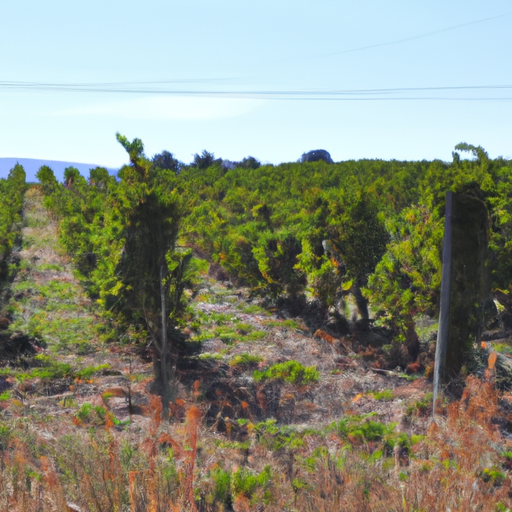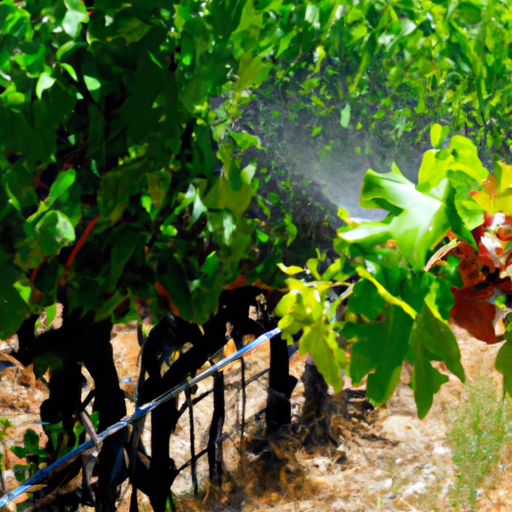
The Role of Irrigation in Shaping Wine Quality and Terroir
The Role of Irrigation in Shaping Wine Quality and Terroir
Irrigation plays a crucial role in the cultivation of grapes for winemaking. It involves the controlled application of water to the vineyard, ensuring that the vines receive the necessary amount of moisture to thrive. However, the impact of irrigation on wine quality and terroir is a topic of much debate among winemakers and experts.
One of the primary concerns regarding irrigation is its potential to dilute the flavors and aromas of the grapes. When vines receive excessive water, the berries tend to grow larger, resulting in a higher juice-to-skin ratio. This can lead to a decrease in the concentration of phenolic compounds, which are responsible for the color, tannins, and flavors in wine. As a result, wines produced from irrigated vineyards may lack the complexity and intensity found in those grown under dry farming conditions.
Furthermore, irrigation can influence the expression of terroir, which refers to the unique characteristics of a wine that are derived from its specific geographic location. The soil composition, climate, and topography of a vineyard all contribute to the terroir, and any alteration to these factors can impact the final product. Irrigation can modify the water availability in the soil, potentially changing the nutrient uptake by the vines and altering the chemical composition of the grapes. This, in turn, can affect the expression of terroir in the resulting wine.
However, it is important to note that irrigation can also be a valuable tool for vineyard management, particularly in regions with limited rainfall or arid climates. By providing water to the vines during dry periods, irrigation helps to maintain vine health and prevent stress-induced diseases. It also allows for better control over grape ripening, as water stress can delay the maturation process. In this way, irrigation can help ensure a consistent and reliable grape harvest, even in challenging environmental conditions.
Moreover, when used judiciously, irrigation can be employed as a tool to fine-tune the balance between vine vigor and grape quality. By carefully managing the timing and amount of water applied, winemakers can influence the growth and development of the vines. This can be particularly beneficial in regions where the natural water supply is unpredictable or insufficient. By providing the vines with the necessary water, winemakers can optimize grape quality and achieve the desired flavor profile in the resulting wine.
In recent years, there has been a growing trend towards more sustainable and environmentally friendly vineyard practices. Many winemakers are exploring alternative irrigation methods, such as deficit irrigation, which involves intentionally reducing water supply to the vines. This approach aims to promote deeper root growth and stress the vines, resulting in smaller berries with more concentrated flavors. By adopting such practices, winemakers can strike a balance between irrigation and terroir expression, producing wines that showcase both the unique characteristics of the vineyard and the desired flavor profile.
In conclusion, irrigation plays a significant role in shaping wine quality and terroir. While excessive irrigation can dilute flavors and alter terroir expression, judicious use of water can help maintain vine health, ensure consistent grape harvests, and fine-tune grape quality. As winemakers continue to explore sustainable vineyard practices, the impact of irrigation on wine production will remain a topic of ongoing research and discussion. Ultimately, the goal is to strike a balance that allows for the expression of terroir while producing wines of exceptional quality.
Understanding the Effects of Irrigation on Grapevine Physiology and Wine Characteristics

The Impact of Irrigation on Wine Quality and Terroir
Understanding the Effects of Irrigation on Grapevine Physiology and Wine Characteristics
Irrigation plays a crucial role in viticulture, the cultivation of grapevines for winemaking. It provides water to the plants, ensuring their survival and growth in regions with limited rainfall. However, the use of irrigation in vineyards has raised concerns about its impact on wine quality and terroir, the unique combination of soil, climate, and other environmental factors that give a wine its distinct character.
To understand the effects of irrigation on grapevine physiology and wine characteristics, it is important to delve into the relationship between water availability and vine development. Water is essential for photosynthesis, the process by which plants convert sunlight into energy. Adequate water supply allows grapevines to produce sugars, which are crucial for the fermentation process and the development of flavors in wine.
However, excessive irrigation can lead to vigorous vine growth, diluting the flavors and aromas of the grapes. This is because water availability affects the balance between vegetative growth and fruit production. When grapevines receive too much water, they focus their energy on producing leaves and shoots, rather than concentrating it in the grapes. As a result, the grapes may lack the intensity and complexity that are characteristic of high-quality wines.
Furthermore, irrigation can influence the composition of the grapes, affecting their sugar and acid levels. Water stress, caused by limited irrigation, can lead to higher sugar concentrations in the grapes, resulting in wines with higher alcohol content. On the other hand, excessive irrigation can dilute the sugar levels, leading to wines with lower alcohol content. Similarly, water availability can affect the acidity of the grapes, which is crucial for the balance and structure of the wine.
In addition to its impact on grapevine physiology, irrigation can also influence the terroir of a wine. Terroir encompasses the unique characteristics of a vineyard, including its soil composition, climate, and topography. These factors interact with the grapevines, shaping the flavors, aromas, and overall quality of the wine. Irrigation, by altering the water availability in the vineyard, can potentially modify the terroir and the expression of these characteristics.
For instance, irrigation can affect the water-holding capacity of the soil, altering its composition and nutrient availability. This, in turn, can influence the uptake of minerals by the grapevines, which are essential for their growth and the development of specific flavors in the grapes. Moreover, irrigation can modify the microclimate of the vineyard, affecting factors such as temperature and humidity. These changes can impact the ripening process of the grapes, ultimately influencing the quality and style of the wine.
In conclusion, irrigation has a significant impact on wine quality and terroir. While it is essential for the survival and growth of grapevines, excessive or inadequate irrigation can lead to imbalances in vine development and grape composition. These imbalances can result in wines that lack complexity and intensity, or wines that have altered sugar and acid levels. Furthermore, irrigation can modify the terroir of a vineyard, potentially altering the unique characteristics that make a wine distinct. Therefore, it is crucial for winemakers to carefully manage irrigation practices to ensure the production of high-quality wines that reflect the true essence of their terroir.
Exploring the Relationship Between Irrigation Practices and Wine Terroir
The Impact of Irrigation on Wine Quality and Terroir
Exploring the Relationship Between Irrigation Practices and Wine Terroir
Wine enthusiasts and connoisseurs often speak of the concept of terroir when discussing the characteristics and quality of a particular wine. Terroir refers to the unique combination of soil, climate, and other environmental factors that influence the taste and aroma of grapes, and ultimately, the wine produced from them. One crucial aspect of terroir that has gained significant attention in recent years is the impact of irrigation practices on wine quality.
Traditionally, many wine regions relied solely on natural rainfall to provide the necessary water for grapevines. However, with changing climate patterns and increasing demand for wine production, irrigation has become a common practice in many vineyards worldwide. While irrigation can be beneficial in ensuring consistent grape growth and preventing drought stress, it also has the potential to alter the terroir and affect the overall quality of the wine.
One of the primary concerns with irrigation is the potential dilution of flavors in the grapes. When vines receive excessive water, the berries tend to grow larger, resulting in a higher juice-to-skin ratio. This can lead to a decrease in the concentration of flavor compounds, such as phenolics and aromatic compounds, which are responsible for the unique characteristics of a wine. As a result, wines produced from irrigated vineyards may lack the complexity and intensity found in wines from non-irrigated vineyards.
Furthermore, irrigation can influence the composition of the soil, which is a crucial component of terroir. Excessive watering can cause leaching of nutrients and minerals from the soil, leading to imbalances that affect grapevine health and grape quality. Additionally, irrigation can alter the microbial activity in the soil, potentially disrupting the symbiotic relationship between the vines and the microorganisms that contribute to the development of unique flavors and aromas in the wine.
However, it is important to note that not all irrigation practices have a negative impact on wine quality and terroir. When used judiciously and in moderation, irrigation can be a valuable tool for vineyard management. Controlled irrigation can help regulate vine growth, prevent water stress during dry periods, and promote optimal grape ripening. By carefully monitoring soil moisture levels and tailoring irrigation schedules to the specific needs of each vineyard block, winemakers can maintain the integrity of the terroir while ensuring consistent grape quality.
Moreover, the impact of irrigation on wine quality is highly dependent on the specific characteristics of the vineyard site. Factors such as soil type, climate, grape variety, and vine age can all influence how irrigation affects the final product. For example, in regions with arid climates or sandy soils that have low water-holding capacity, irrigation may be necessary to sustain vine growth and prevent vineyard decline. In contrast, in cooler climates or regions with well-draining soils, excessive irrigation may be detrimental to wine quality.
In conclusion, the relationship between irrigation practices and wine terroir is a complex and multifaceted one. While irrigation can have both positive and negative effects on wine quality, it is essential for winemakers to strike a balance between ensuring vine health and preserving the unique characteristics of the terroir. By understanding the specific needs of their vineyards and implementing sustainable irrigation practices, winemakers can continue to produce wines that reflect the true essence of their terroir.






